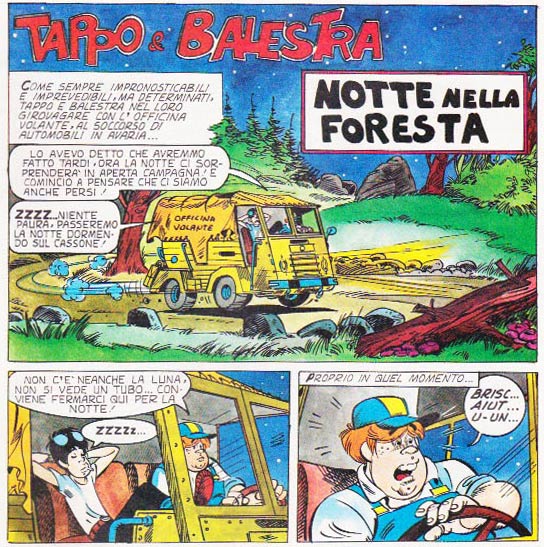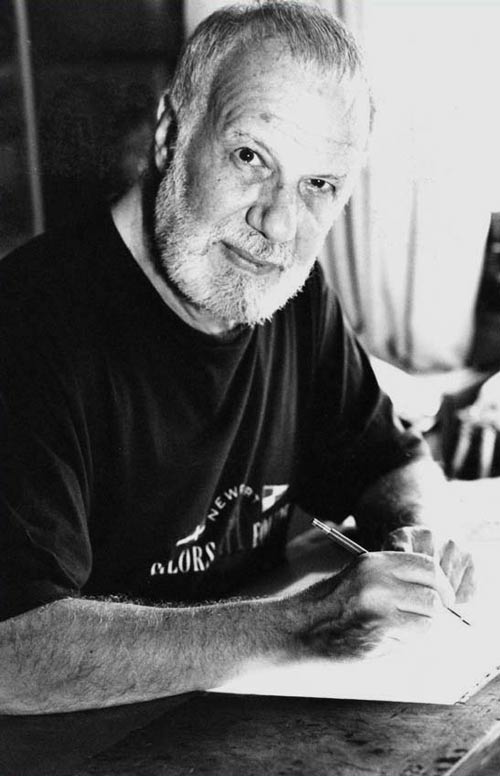Leone ("Leo") Cimpellin was a prolific Italian comic artist, whose career spanned from the 1940s through the early 2000s. He was initially an artist of adventure and western comics for publishers like Audace and Alpe, before becoming a productive contributor of humorous series to the children's comic magazine Corriere dei Piccoli in the 1950s and 1960s. He is however best-known for the monthly satirical crime series 'Jonny Logan' (1972-1978), made with writer Romano Garofalo for Edizioni Dardo. Together with writer Romano Garofalo, he also created 'Alem' (1971-1973), an 'Asterix'-like series set in Ancient Rome, but sympathizing with the Romans instead. Cimpellin remained active until the early 2000s, working mainly on agency work, TV tie-in comics and Bonelli series.
'Jonny Logan'. French-language version.
Early life and career
Leone Cimpellin was born in 1926 in Rovigo, in the North East of Italy, but moved to Milan while still a child. His earliest graphic influence was Alex Raymond, but he was later also inspired by more humorous comic artists, most obviously Albert Uderzo. Cimpellin began his career as a pupil of the Italian comic book artist Lina Buffolente, with whom he made the comic story 'Le Avventure di Petto di Pollo' (La Lito, 1946). After this first effort, he spent the next year contributing to the animated cartoons of Nino and Toni Pagot. He created adventure comics for the Milanese publishing house Audace, using pen names like Alex Lyon and Cimp. Cimpellin teamed up with Gianluigi Bonelli to create the masked avenger 'Plutos' (1949-1950). During the same period, he and Bonelli also worked on episodes of the western comic book 'Red Carson'. This series was in fact an Italian version of the American newspaper comic 'Casey Ruggles' by Warren Tufts, for which Mario Uggeri and Franco Bignotti were also contributing artists.
Cimpelin additionally drew the 33 issues of the historical saga 'Il Tamburino del Re' ('Drummer of the King', 1951-1952), written by Cesare Soini for the Belle Avventure collection of Edizioni Alpe. This comic was published in France as 'Le Petit Tambour du Roi' in Pipo in 1952-1954. Cimpellin drew twelve issues of the follow-up series 'Camicia Rossa' (1952) for the same collection, followed by the back-up feature 'Don Cicciotte' in Alpe's Picchiarello (Woody Woodpecker) comic book in 1956. For the publisher Pietro Berretta he drew 'Sten il Giramondo' (1949-1950), about the Australian adventurer Joy Sten and his pal Pat. The series was written by Gian Giacomo Dalmasso. In 1952, he drew 'Canadian King' in cooperation with Armando Bonato for the publishing house E.G.L.A. The comic ran in the French comic book Diavolo as 'Rudy le Trappeur'.
Between 1953 and 1954, Cimpellin was one of the artists of Guido Martina's western comics 'Pecos Bill' and 'Oklahoma' in the collection Albi d'Oro of the publisher Mondadori. Other artists for these productions were Raffaele Paparella, Pier Lorenzo De Vita and Giovanni De Gasperi. Starting in 1962, he drew locally produced stories for 'Nembo Kid', Mondadori's edition of the 'Superman' comic book, which mostly ran American stories by Wayne Boring, Curt Swan and Al Plastino. Further western work by Cimpellin appeared in the collection Ariete Grandi Avventure of the publishing house Ariete in 1954. In addition to his comic book work, Cimpellin illustrated news stories for the newspaper La Domenica del Corriere, and contributed to the magazine Amica.
Il Corriere dei Piccoli
The largest part of Cimpellin's output of the 1950s and 1960s could be read in the children's magazine Il Corriere dei Piccoli, for which he became a staff artist in 1953. He established himself as a talented humor artist, working with scriptwriters like Guglielmo Zucconi, Carlo Triberti and Vezio Melegari on a variety of series. His most notable (co-)creations for this magazine were 'Papero Grosso e Fiorello' (1954), about a fat peasant and his little pig, 'Codinzolo', about a little faun, and 'Gibernetta' (1958), a parody of army life. These were followed by the reckless driver 'Carletto Sprint' (1961), the tragicomic adventures of the Roman legionary 'Tribunzio' (with Triberti, 1966) and the journalist 'Gigi Bizz' (1967). Further creations for the Corriere were the space adventures of a quiet ministry official and his robot, 'Gianni & Rob-8' (1969), as well as 'Gelsomino', 'Tam Tam' and 'Nero Fumo'. Several of his creations for this magazine have been reprinted in publications from Spain, Argentina, Turkey and Chile.
Work for Franco Fasani
Besides his regular work for the Corriere, Cimpellin found time to contribute artwork to the publisher Franco Fasani as well. He drew features like 'Indian Sarge', 'Il Sgt. McKarty' and 'Celestino il Tigre Marino' for the collection Oscar (1960-1964), as well as 'Svanitella' for Girandola TV (1963-1964), which featured comics based on Paul Campani's creations for the animated TV show 'Carosello' (1957-1977). Much of his work for Fasani appeared in France in comic books published by Artima.
Advertising career
Cimpellin also worked extensively for the advertising industry. One of his best-known creations is the tiger mascot for Esso petrol stations, who was presented as 'Un Tigre nel Motore' ('A Tiger in the Motor', 1966).
Erotic comics
Cimpellin even ventured into erotic comics for a while, drawing 'Belfagor L'Arcidiavolo' (1967-1969) for EdiPeriodici and 'Top' for Edizioni Lo Squalo (with Renzo Barbieri, 1974).
Agency work
Cimpellin worked as an agency artist for Roy D'Ami's studio too. From the mid-1960s until the early 1970s, he produced western stories for Lug, the Lyon-based publisher of pocket comic books. These included features like 'Rex l'Audace' (in Fox), 'Sergent Guib' (in Kiwi), 'Zapo' (in Bronco), 'Ted Brenton' (in Blek), 'Ben Catastroph' (in Ombrax) and 'Dan Tempête' (in Zembla). One of his lesser known creations is his comic about French 17th-century rascal 'Tom Patapom', who runs away from home and finds himself in adventures all over the world (and in space). The young adventurer first appeared in the short-lived French magazine Tchak! (Ed. Aventures et Voyages) in 1969, and then in the German comic book Félix (Bastei Verlag) in 1972-1973. Cimpellin additionally drew war stories and features like 'Spy 13' and 'Dick Turpin' for the publications of Fleetway and DC Thomson in the UK.
Alem
In his home country, Cimpellin penciled some stories for the 'Diabolik' comic book, and then teamed up with writer Romano Garofalo to create 'Alem' for Gattei & Pinzi Editori (1971-1973) under the pen name Gilbert. The latter was an attempt to copy the success of the French hit series 'Astérix et Obélix' by René Goscinny and Albert Uderzo. Naturally, this series is told from the viewpoint of the Romans, during the days of the emperor Marcus Aurelian. The three main stars are tasked with defending the empire against barbarian invasions. Title hero is the small but strong and courageous Alem. Onass is an honest craftsman and the friendly Cassius is helped in battle by the magical golden ball of the goddess Minerva. 48 episodes of Italy's "reponse" to 'Asterix' were published during a two-year period.
Jonny Logan
Leone Cimpellin and Romano Garofalo were more successful with their humorous comic book series 'Jonny Logan' (1972-1978), published by Dardo. This satirical strip featured a crackpot team of bounty hunters, and was filled with nods and winks to the topical problems of Italy at the time, such as terrorism, mafia infiltration in politics, taxes, and internal emigration. It was made in the same tradition as the 'Alan Ford' comic books by Magnus and Max Bunker, which parodied the secret agents genre. Cimpellin, who signed with "Ghilbert", based the looks of his grotesque character on actor and comedian Lando Buzzanca. The series ran for 77 issues, and sold over 100,000 copies per month during its peak. The series was also published in France, Greece and Yugoslavia, knew several fan clubs and was made into a series of animated shorts for the RAI TV-series Supergulp.
Maxmagnus
Cimpelin worked with writer Max Bunker on 'Maxmagnus', a dark humor fable set in the Middle Ages. Originally a series of short stories by Bunker and artist Magnus for Eureka (1968-1970), it was turned into a regular comic book series by Editoriale Corno in 1979. Cimpellin was the original artist of this comic book, and was succeeded by Domenico Marino, Piercarlo Macchi and Gianni Bono's Staff di If collective.
Other work and Studio Cimpelin
Other 1970s work by Cimpelin includes stories for Horror (Gino Sansoni Editore, 1970-1972), the creation of the character 'Il Barone Von Strip' with Romano Garofalo for Il Mago (Mondadori, 1977), and 'Kid Barboun' in the monthly Eureka (Editoriale Corno). He also made drawings about sporting events for La Gazzetta del Popolo, and trained young artists in his Studio Cimpellin. Among his pupils were Giampiero Casertano, Enea Riboldi, Stefano Tognetti, Carlo Ambrosini, Nicola Mari and several others.
'Tappo e Balestra' - 'Notte Nella Foresta'.
Work in the 1980s
In the 1980s, Cimpellin drew various series for the boys' monthly magazine Più of Editoriale Domus, such as 'Tappo e Balestra' (1982-1984), 'Mister T' (1985-1986), 'Tom-Tom' (with Roberto Renzi, 1985-1986), 'El Chico Mas' (with Roberto Renzi, 1986), 'I Predatori del Tempo' (1986-1987) and 'Tony Express' (1987-1988). For both TV Junior and Il Corrierino, he drew a great many comic strips based on mostly Japanese anime series during the 1980s and early 1990s. These include 'Falco il Superbolide' ('Machine Hayabusa', created by Mikiya Mochizuki), 'Ryu il Ragazzo delle Caverne' ('Genshi shōnen Ryū', created by Shotaro Ishinomori), 'Chobin, il Principe Stellare' ('Chobin the Star Child', created by Shotaro Ishinomori), 'Galaxy Express 999' (created by Leiji Matsumoto), 'Lady Oscar' ('The Rose of Versailles', created by Riyoko Ikeda), 'Daltanious - Il Robot del Futuro' ('Future Robot Daltanious', created by Yoshiyuki Tomino), 'Teenage Mutant Ninja Turtles' (based on the characters by Kevin Eastman and Peter Laird), 'Il Tulipano Nero' ('La Seine no Hoshi', created by Mitsuru Kaneko), 'Flo, La Piccola Robinson' ('The Swiss Family Robinson: Flone of the Mysterious Island', based on the Johann Wyss novel), 'I Tre Moschettieri' ('The Three Musketeers') and 'Big Mac Fargo'.
'Daltanious - Il Robot del Futuro'.
By the end of 1980s, Cimpellin returned to the publishing house Sergio Bonelli Editore (previously Audace). He drew the episodes 'I Misteri di Londra' (1989), 'La Terra Che Non C'è' (1989), 'Incroci Pericolosi' (1994) and 'La Città Impazzita' (1994) in the comic book series about adventurer 'Martin Mystère', created by Alfredo Castelli. Together with Paolo Di Clemente, he provided the artwork of 'Il Vendicatore Mascherato', the 49th installment in Bonelli's sci-fi series 'Nathan Never' (script by Bepi Vigna).
Work in the 1990s and 2000s
In the early 1990s, Cimpellin was back at Dardo as a pencil artist for Gianfranco Manfredi's 'Gordon Link' character, while also contributing stories to the Tiramolla comic book. In Il Giornalino, he made a series about Ancient Rome with Carlo Pedrocchi, 'S.P.Q.R.' which starred Duralex and the ex-slave Spaccakran. Another series for this magazine was 'Chichillo' (1996-2001), made with Toni Pagot. In cooperation with Oscar Scalco, he provided the artwork and character designs of the comic series 'Zoollywood' (2003), written by Davide Barzi.
Graphic contributions
At the occasion of the 40th anniversary of the character 'Il Comandante Mark' by EsseGesse in 2006, Cimpellin drew the story 'Avventura ai Caraibi', which appeared in the 45th issue of Mark by IF Edizioni.
Death and legacy
Leone Cimpellin passed away in Milan on 27 March 2017, at the age of 91. The work of the highly prolific Cimpellin was praised by none other than Hugo Pratt and also a strong influence on Nikos Nikolaidis.
Books about Leo Cimpellin
For those interested in Cimpelin's life and career, Davide Barzi's book 'Leo Cimpellin/Leo Ortolani' (Edizioni IF, 2002) is highly recommended.
Leone Cimpellin.
















